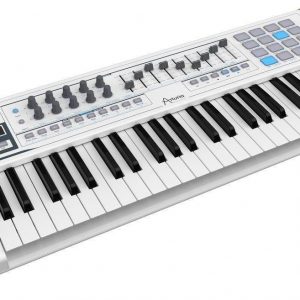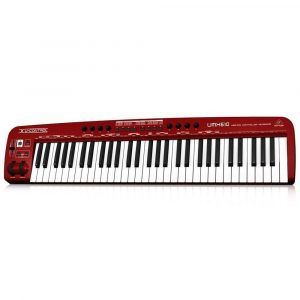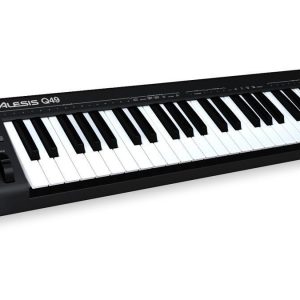Korg NanoKontrol2
$34.99
The Korg NanoKontrol2 midi keyboard is the ultimate portable tool for intuitive control over your music productions.
Compare
Description
Korg NanoKontrol2 is a MIDI controller that is compact in size and designed to make music production easier. The device is ideal for musicians, producers, and sound designers who want to control their software or hardware instruments efficiently.
One of the most significant advantages of the NanoKontrol2 is its compact and portable design. It is small enough to fit in a backpack or laptop bag, making it perfect for those who need to travel frequently. The device measures only 12.4 x 3.27 x 1.18 inches and weighs just 0.64 pounds, making it easy to transport from one place to another.
The NanoKontrol2 has eight faders, knobs, and buttons, making it suitable for controlling DAW parameters, virtual instruments, and various hardware synthesizers. It also features a transport section, which enables the user to control playback, record, and stop functions, as well as other essential functions like looping and scanning.
Another advantage of the NanoKontrol2 is how it is easy to set up and use. The controller supports both USB and MIDI connectivity, making it compatible with virtually every computer system and DAW software. It also comes with a Korg Kontrol Editor, a dedicated software that enables you to customize the functions of each fader, knob, and button to suit your specific needs.
The NanoKontrol2 also has a remarkable build quality that is designed to withstand rigorous use. The controller has a rugged, rubberized finish that provides a secure grip, preventing it from slipping while in use. The buttons and knobs are also designed to last long, ensuring that the user can enjoy reliable performance for years to come.
The NanoKontrol2 is an excellent MIDI controller for users looking to streamline their music-making process, and its compact design ensures that users can stay mobile without sacrificing functionality. Additionally, the controller’s support for customization via software makes it an extremely flexible and versatile addition to the user’s workflow. The NanoKontrol2 truly delivers a lot of value in an affordable and compact package and is an excellent choice for anyone looking for a reliable and portable MIDI controller.
Korg NanoKontrol2 properties
| Product name |
NanoKontrol2 |
| Brand |
Korg |
| Type |
Keyboard Instruments |
| Keyboard Instrument |
MIDI Keyboard |
| Drawbars/Sliders |
Yes |
| Rotary Controls |
Yes |
| Colour |
Black |
Frequently Asked Questions:
How does the CC assignment feature on the Korg NanoKontrol2 differ from traditional MIDI controllers?
The CC (Control Change) assignment feature on the Korg NanoKontrol2 sets it apart from traditional MIDI controllers. While most MIDI controllers come pre-mapped with fixed functions for their knobs and buttons, the NanoKontrol2 allows for user-defined CC assignments. This means that you can customize the behavior of each control to match your specific needs in your DAW or synthesizer software. Whether you want to assign a knob to adjust a specific parameter in your virtual instrument or map a button to trigger a macro command, the flexibility of CC assignment on the NanoKontrol2 gives you greater control over your creative process.
How do I properly program and map Korg NanoKontrol2's parameters using MIDI software on a computer?
To properly program and map the parameters of your Korg NanoKontrol2 using MIDI software on a computer, follow these steps:
1. Connect the Korg NanoKontrol2 to your computer using a USB cable. Install the driver for the Korg NanoKontrol2, if necessary. You can download the driver from the Korg website. Open your MIDI software, such as Ableton Live or Logic Pro X. In your MIDI software, go to the MIDI Preferences or Setup menu and select "MIDI Input" or "MIDI Setup". Select the Korg NanoKontrol2 from the list of available MIDI devices. If you want to assign specific functions or parameters to the knobs, buttons, and sliders on the Korg NanoKontrol2, go to the Mapping or Assignment section in your MIDI software. In the Mapping section, select the parameter you want to map (such as volume or pan) and assign it to a specific knob or slider on the Korg NanoKontrol2. Repeat this process for all of the parameters you want to map. Test your mapping by playing a sound in your MIDI software and adjusting the knobs and buttons on the Korg NanoKontrol2. You should see the corresponding parameter changing in your MIDI software. Save your MIDI mapping as a preset or template, so you can easily recall it later. If you want to use the Korg NanoKontrol2 with multiple MIDI devices or applications, create separate mappings for each device or application. To switch between mappings, go to your MIDI software's Setup menu and select the desired mapping from the list of saved presets or templates. Remember to always perform the task to the best of your ability. By following these steps, you should be able to program and map your Korg NanoKontrol2 using MIDI software on a computer.
How does the Korg NanoKontrol2's MIDI mapping function enable customization of its control assignments to suit specific music production software or hardware configurations?
The Korg NanoKontrol2's MIDI mapping function allows users to assign specific MIDI commands to its various controls, such as knobs and buttons. This enables the user to tailor the control assignments to match their preferred music production software or hardware configuration. Whether working with digital audio workstations (DAWs) like Ableton Live, Logic Pro X, or FL Studio, or using external MIDI devices like synthesizers or drum machines, the NanoKontrol2's MIDI mapping function provides a high degree of flexibility and versatility in controlling these tools. With this customization capability, users can streamline their workflow and optimize their creativity by having quick access to the features they need at their fingertips.
What unique features does the Korg NanoKontrol2 offer when connected to a computer via USB, and how can it be utilized to enhance music production using MIDI Keyboard technology?
The Korg NanoKontrol2 is a compact and lightweight MIDI controller that offers several unique features when connected to a computer via USB. One of its standout features is the ability to control multiple virtual instruments and effects plug-ins simultaneously, thanks to its 16 assignable knobs, faders, and buttons. The device also has an LED display that provides real-time feedback on parameter values, making it easy to adjust settings quickly and accurately. Additionally, the NanoKontrol2 comes with a software editor that allows users to customize the controller's behavior and assign functions to its various controls. When used in music production using MIDI Keyboard technology, the Korg NanoKontrol2 can greatly enhance workflow and creativity. It allows for quick and intuitive access to important parameters, which is especially helpful when working with complex virtual instruments or effects chains. The LED display also makes it easy to keep track of settings and make adjustments on the fly. Overall, the Korg NanoKontrol2 is a versatile and powerful MIDI controller that is well-suited for use in music production settings. Its compact size, extensive functionality, and affordable price point make it an attractive option for both beginners and experienced producers alike.
What is the exact procedure for resetting the Korg NanoKontrol2 to its default settings while still retaining all user-programmed control assignments and preferences?
1. First, make sure your computer is connected to the NanoKontrol2 via USB. This will ensure that the device's memory isn't cleared during the reset process. Open the Korg Control Editor software on your computer and select the "Advanced" tab in the top menu bar. Click on "NanoKontrol2" under the list of connected devices to bring up its configuration settings. In the settings window, click on the "Reset" button at the bottom left corner of the screen. A dialogue box will pop-up asking you if you're sure you want to reset your NanoKontrol2 to its default settings. Click "Yes" to proceed with the reset. The device will now be reset to its factory settings, but all user-programmed control assignments and preferences will be retained. Once the reset process is complete, disconnect your computer from the NanoKontrol2 and then reconnect it again to ensure that all settings are properly updated. After reconnecting your computer, launch the Korg Control Editor software again and verify that all control assignments and preferences have been retained by checking the device's configuration settings in the "Advanced" tab.
What are the exact procedures to configure and troubleshoot a non-responsive MIDI channel on the Korg NanoKontrol2, particularly when using a USB connection?
First, ensure that your NanoKontrol2 is properly powered on. Sometimes, simple restarts can resolve connectivity issues. USB Connection**: Verify that your USB cable is securely connected to both the Korg device and your computer. Try using a different USB port or cable if possible. MIDI Settings
- **Check the MIDI Channel Assignment**: On the NanoKontrol2, press the "MIDI CH" button until the desired channel number appears on the display. Typically, you'll want to use channel 1 for most applications. Select the Correct MIDI Mode**: Press the "MIDI MODE" button to cycle through the different modes (e. MIDI OUT, MIDI THRU). Ensure that you're sending and receiving data from/to the correct port. MIDI Settings in Your DAW
- **Check the Input/Output Settings**: In your digital audio workstation (DAW), ensure that the input for the Korg NanoKontrol2 is selected correctly in both the MIDI settings and any applicable routing or monitor sections. MIDI Port Configuration**: Some DAWs require you to specify which ports are used for sending and receiving. Verify that this configuration matches your expectations. Troubleshooting Steps
- **Reset All Settings**: The Korg NanoKontrol2 has a reset function that can be accessed by holding down the "MIDI CH" button and pressing the "POWER" button simultaneously while powering on. This resets all settings to their factory defaults. Use a MIDI Monitor Tool**: Tools like MIDI OX (for Windows) or Bome's Midi Translator (for both Mac and PC) can help monitor incoming and outgoing MIDI data. This can identify if there are issues with the data being sent from your DAW to the controller. Advanced Troubleshooting
- **Check for Firmware Updates**: Sometimes, updates can resolve connectivity or compatibility issues. Reinstall Driver (Windows) or MIDI Utility (Mac)**: If using a USB connection and you're still experiencing issues, try reinstalling drivers or utilities that manage MIDI connections. Final Steps
- **Consult the User Manual**: The user manual for your DAW and the Korg NanoKontrol2 may have specific instructions or workarounds that are not covered here. Seek Support**: If none of these steps resolve the issue, consulting Korg support forums or contacting them directly might provide more detailed assistance tailored to your situation. By following these procedures, you should be able to identify and possibly fix issues related to a non-responsive MIDI channel on your Korg NanoKontrol2 when using a USB connection.
Before you buy Korg NanoKontrol2







Louis Frederick –
I recently purchased the Korg NanoKontrol2 from an online shop and my overall rating for the experience is 4 out of 5. The delivery was prompt and the packaging was intact, ensuring the safety of the product during transit.
The Korg NanoKontrol2 is a compact and portable MIDI controller that offers a wide range of control options for music production and live performances. It features eight faders, knobs, and buttons, as well as transport controls, making it a versatile tool for controlling various parameters in software applications.
One important aspect to consider when buying a MIDI keyboard is the quality and responsiveness of the keys. While the Korg NanoKontrol2 does not have traditional piano-style keys, it still offers a satisfactory playing experience. The keys on this device are not weighted or velocity-sensitive, which means they don’t respond to the intensity of your touch. However, this is not a major drawback for me as I primarily use it for controlling parameters rather than playing melodies.
The reason I chose the Korg NanoKontrol2 is its compact size and portability. It easily fits in my backpack, allowing me to take it wherever I go. Additionally, the build quality is excellent, and the knobs and faders have a good amount of resistance, providing a tactile feel while adjusting parameters.
Here are some tips and tricks that might help individuals interested in buying a MIDI keyboard:
1. Consider your specific needs: Before purchasing a MIDI keyboard, think about the features and functionalities you require. Do you need a full-sized keyboard or a compact one? Do you prioritize piano-style keys or other control options?
2. Research compatibility: Ensure that the MIDI keyboard you choose is compatible with your computer operating system and music software. Some keyboards may require drivers or have specific compatibility requirements.
3. Check for additional features: Look for additional features like programmable buttons, pads, and sliders that can enhance your workflow and creativity.
4. Read user reviews: It can be helpful to read reviews from other users to get a sense of the keyboard’s performance, build quality, and customer support.
5. Consider your budget: MIDI keyboards come in a wide range of prices, so it’s important to set a budget and find a keyboard that fits within it while still meeting your requirements.
In conclusion, my experience with buying the Korg NanoKontrol2 from this online shop was satisfactory. The keyboard’s compact size and portability are its standout features, and while the keys may not be weighted or velocity-sensitive, they still provide a decent playing experience. I would recommend this MIDI keyboard to those who prioritize portability and versatile control options.